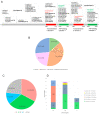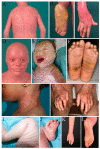Mutational Spectrum of the ABCA12 Gene and Genotype-Phenotype Correlation in a Cohort of 64 Patients with Autosomal Recessive Congenital Ichthyosis
- PMID: 36980989
- PMCID: PMC10048568
- DOI: 10.3390/genes14030717
Mutational Spectrum of the ABCA12 Gene and Genotype-Phenotype Correlation in a Cohort of 64 Patients with Autosomal Recessive Congenital Ichthyosis
Abstract
Autosomal recessive congenital ichthyosis (ARCI) is a non-syndromic congenital disorder of cornification characterized by abnormal scaling of the skin. The three major phenotypes are lamellar ichthyosis, congenital ichthyosiform erythroderma, and harlequin ichthyosis. ARCI is caused by biallelic mutations in ABCA12, ALOX12B, ALOXE3, CERS3, CYP4F22, NIPAL4, PNPLA1, SDR9C7, SULT2B1, and TGM1. The most severe form of ARCI, harlequin ichthyosis, is caused by mutations in ABCA12. Mutations in this gene can also lead to congenital ichthyosiform erythroderma or lamellar ichthyosis. We present a large cohort of 64 patients affected with ARCI carrying biallelic mutations in ABCA12. Our study comprises 34 novel mutations in ABCA12, expanding the mutational spectrum of ABCA12-associated ARCI up to 217 mutations. Within these we found the possible mutational hotspots c.4541G>A, p.(Arg1514His) and c.4139A>G, p.(Asn1380Ser). A correlation of the phenotype with the effect of the genetic mutation on protein function is demonstrated. Loss-of-function mutations on both alleles generally result in harlequin ichthyosis, whereas biallelic missense mutations mainly lead to CIE or LI.
Keywords: ABCA12; ARCI; congenital ichthyosiform erythroderma; harlequin ichthyosis; lamellar ichthyosis.
Conflict of interest statement
The authors declare no conflict of interest.
Figures


Similar articles
-
Cross-Sectional Study on Autosomal Recessive Congenital Ichthyoses: Association of Genotype with Disease Severity, Phenotypic, and Ultrastructural Features in 74 Italian Patients.Dermatology. 2024;240(3):397-413. doi: 10.1159/000536366. Epub 2024 Apr 8. Dermatology. 2024. PMID: 38588653 Free PMC article.
-
Genotype of autosomal recessive congenital ichthyosis from a tertiary care center in India.Pediatr Dermatol. 2022 May;39(3):420-424. doi: 10.1111/pde.14944. Epub 2022 Apr 12. Pediatr Dermatol. 2022. PMID: 35412663
-
Update on autosomal recessive congenital ichthyosis: mRNA analysis using hair samples is a powerful tool for genetic diagnosis.J Dermatol Sci. 2015 Jul;79(1):4-9. doi: 10.1016/j.jdermsci.2015.04.009. Epub 2015 Apr 30. J Dermatol Sci. 2015. PMID: 25982146 Review.
-
Genotype-phenotype correlation in a large English cohort of patients with autosomal recessive ichthyosis.Br J Dermatol. 2020 Mar;182(3):729-737. doi: 10.1111/bjd.18211. Epub 2019 Aug 26. Br J Dermatol. 2020. PMID: 31168818
-
ABCA12 mutations and autosomal recessive congenital ichthyosis: a review of genotype/phenotype correlations and of pathogenetic concepts.Hum Mutat. 2010 Oct;31(10):1090-6. doi: 10.1002/humu.21326. Hum Mutat. 2010. PMID: 20672373 Review.
Cited by
-
Compound heterozygous ABCA12 variants identified in a Chinese patient with congenital ichthyosiform erythroderma: Advancing genotype-phenotype correlations and literature review.Mol Genet Genomic Med. 2024 May;12(5):e2431. doi: 10.1002/mgg3.2431. Mol Genet Genomic Med. 2024. PMID: 38702946 Free PMC article. Review.
-
Prenatal opioid exposure significantly impacts placental protein kinase C (PKC) and drug transporters, leading to drug resistance and neonatal opioid withdrawal syndrome.Front Neurosci. 2024 Aug 19;18:1442915. doi: 10.3389/fnins.2024.1442915. eCollection 2024. Front Neurosci. 2024. PMID: 39238930 Free PMC article.
-
Benefits of topical natural ingredients in epidermal permeability barrier.Front Physiol. 2024 Jan 4;14:1275506. doi: 10.3389/fphys.2023.1275506. eCollection 2023. Front Physiol. 2024. PMID: 38239888 Free PMC article. Review.
-
Erythrokeratodermia Variabilis-like Phenotype in Patients Carrying ABCA12 Mutations.Genes (Basel). 2024 Feb 24;15(3):288. doi: 10.3390/genes15030288. Genes (Basel). 2024. PMID: 38540347 Free PMC article.
References
-
- Rajpopat S., Moss C., Mellerio J., Vahlquist A., Gånemo A., Hellstrom-Pigg M., Ilchyshyn A., Burrows N., Lestringant G., Taylor A., et al. Harlequin ichthyosis: A review of clinical and molecular findings in 45 cases. Arch. Dermatol. 2011;147:681–686. doi: 10.1001/archdermatol.2011.9. - DOI - PubMed
-
- Paller A.S., Renert-Yuval Y., Suprun M., Esaki H., Oliva M., Huynh T.N., Ungar B., Norma Kunjravia N., Friedland R., Peng X., et al. An IL-17-dominant immune profile is shared across the major orphan forms of ichthyosis. J. Allergy Clin. Immunol. 2017;139:152–165. doi: 10.1016/j.jaci.2016.07.019. - DOI - PMC - PubMed
MeSH terms
Substances
Grants and funding
LinkOut - more resources
Full Text Sources

